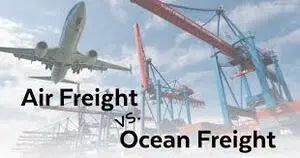Shipping from Nepal: Air vs. Ocean Shipping
When it comes to international shipping from Nepal, choosing between air shipping and ocean shipping is a crucial decision that can impact your business's efficiency, costs, and customer satisfaction. Both options offer distinct advantages and disadvantages, and selecting the right mode of transportation depends on various factors. In this comprehensive guide, we'll delve into the considerations, benefits, and drawbacks of air and ocean shipping from Nepal.

Air Shipping: Speed and Efficiency
Air shipping involves the transportation of goods via airplanes. It is renowned for its speed and efficiency, making it an attractive choice for time-sensitive shipments. Here's a closer look at the pros and cons of air shipping:
Advantages of Air Shipping:
-
Speed: Air shipping is unmatched in terms of speed. Goods can reach their destination in a matter of days, making it ideal for perishable items and urgent deliveries.
-
Reliability: Airlines adhere to strict schedules, minimizing unexpected delays and ensuring timely deliveries.
-
Reduced Packaging: Since goods spend less time in transit compared to ocean shipping, you might require less robust packaging, reducing overall shipping costs.
-
Global Reach: Airports are well-connected across the world, enabling easy access to even remote or landlocked destinations.
Disadvantages of Air Shipping:
-
Cost: The most significant drawback of air shipping is its cost. Airfreight rates are considerably higher compared to ocean shipping due to the expedited service.
-
Weight and Size Restrictions: Air shipments are subject to weight and size limitations imposed by airlines. This can affect the type and quantity of goods you can transport.
-
Limited Capacity: During peak seasons, the available space on airplanes might be limited, leading to potential capacity issues.
Ocean Shipping: Affordability and Versatility
Ocean shipping involves transporting goods via cargo ships that traverse the world's oceans. This option is known for its cost-effectiveness and suitability for bulk shipments. Here's an in-depth look at the advantages and disadvantages of ocean shipping:
Advantages of Ocean Shipping:
-
Cost-Effective: Ocean shipping offers significant cost savings compared to air shipping. It's the preferred choice for larger shipments or businesses with budget constraints.
-
High Capacity: Cargo ships have substantial capacity, making them ideal for transporting large quantities of goods.
-
Versatility: Ocean shipping can accommodate a wide range of cargo types, including vehicles, machinery, and bulk commodities.
Disadvantages of Ocean Shipping:
-
Time: Ocean shipping is notably slower than air shipping. Deliveries can take weeks or even months, making it unsuitable for time-sensitive shipments.
-
Potential Delays: Factors such as weather conditions, port congestion, and customs procedures can lead to delays in ocean shipments.
-
Transshipment: Depending on the destination, goods might need to be transferred between different ships or ports, potentially adding complexity and delays.
Making an Informed Decision:
-
Urgency and Time Sensitivity: If your shipment is time-sensitive, air shipping is the clear choice. For non-urgent shipments, ocean shipping might be more suitable.
-
Budget Constraints: Consider your budget. Air shipping is costlier but faster, while ocean shipping is more affordable but slower.
-
Nature of Goods: Fragile, perishable, or high-value items are better suited for air shipping. Bulk goods, machinery, and vehicles can be efficiently transported via ocean shipping.
-
Destination Accessibility: If you're shipping to a landlocked or distant area, air shipping might be more practical due to the better accessibility of airports.
-
Cargo Volume: Smaller shipments can be economically viable through air shipping, while larger quantities are often better suited for ocean shipping.
-
Customs and Regulations: Research and understand the import/export regulations and customs procedures for both shipping methods to avoid complications.
In conclusion, the choice between air shipping and ocean shipping from Nepal depends on your unique business needs. Evaluate the urgency, budget, cargo type, and destination to determine the most suitable option. For time-sensitive shipments and high-value goods, air shipping offers unmatched speed, while ocean shipping provides cost-effectiveness and capacity for larger shipments. By carefully considering these factors, you can make an informed decision that optimally aligns with your business goals.
When discussing shipping from Nepal, you need to consider both air and ocean shipping options. Both have their advantages and disadvantages, so understanding them will help you make the best decision for your business. This comprehensive comparison looks at key factors like costs, transit times, reliability, and environmental impact to give you a clear picture of what to expect.
Air shipping from Nepal is generally the preferred method for those who need their goods delivered quickly. While more expensive, it offers significantly shorter transit times compared to ocean shipping. The faster delivery is crucial for perishable goods, high-value products, and time-sensitive shipments. The reliability of air shipping is also higher, with fewer risks of delays caused by weather conditions or port congestion. However, air shipping has its limitations, such as increased shipping costs, weight restrictions, and a larger carbon footprint.
On the other hand, ocean shipping from Nepal is a cost-effective solution for businesses dealing with large quantities of goods. Despite its longer transit times, ocean shipping is more economical, particularly for bulky or heavy items that would be prohibitively expensive to ship by air. Ocean shipping also boasts a lower carbon footprint, making it a more environmentally friendly option. Ports can handle a wide variety of cargo types, including hazardous materials that may not be allowed on planes. However, ocean shipping comes with its own set of challenges, such as longer lead times, potential delays due to weather or port congestion, and the need for precise coordination and logistics planning.
In conclusion, the choice between air and ocean shipping from Nepal depends on several factors, including your budget, the nature of your goods, and the urgency of your shipment. If you prioritize speed and reliability, air shipping is the way to go. But if cost-effectiveness and environmental concerns are at the top of your list, ocean shipping might be more suitable. Assess your needs carefully to make a well-informed decision that aligns with your business goals.

